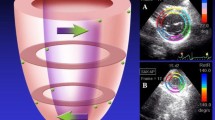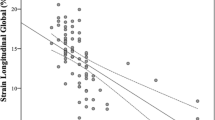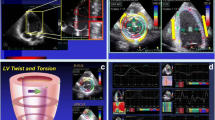Abstract
Cardiomyopathy is a major cause of death in Chagas disease and early detection of cardiac involvement is essential. Myocardial strain is a reliable technique for assessment of subtle left ventricular (LV) contractility alterations. This study assessed LV global longitudinal strain (GLS) in a large Chagas disease population living in remote areas. Between 2015 and 2016, Chagas disease patients were selected in the northern of the Minas Gerais state. All patients underwent T. cruzi antibodies tests and those who had positive tests were included. A resting 12-lead ECG was recorded and classified using the Minnesota Code criteria. Echocardiography was performed at public health primary care units and speckle-tracking strain was analyzed offline. LV dysfunction was defined as ejection fraction (LVEF < 50%) and reduced GLS was defined as < 16% (absolute value). A total of 1387 patients were included, mean age of 60.0 ± 12.5 years, 68% were women, and 14% had LV dysfunction. Among patients with normal LVEF, 59% had impaired LV GLS. Overall, patients with impaired GLS were older, had more comorbidities and ECG abnormalities than those with normal GLS. The independent factors associated with reduced GLS were ST-T abnormalities (OR 1.954; 95% CI 1.027–3.718), QRS duration (OR 1.009; 95% CI 1.002–1.016), LVEF (OR 0.947; 95% CI 0.923–0.972), and E/e’ ratio (OR 1.059; 95% CI 1.009–1.112). In a cohort of Chagas disease from endemic areas, impaired LV GLS was detected in a significant proportion of patients, despite normal ECG and preserved LVEF. The main determinants of reduced LV GLS were ST-T abnormalities, QRS duration, LVEF and E/e' ratio, adjusting for demographical and clinical data.



Similar content being viewed by others
References
WHO/PAHO (2016) Neglected infectious diseases in the Americas: success stories and innovation to reach the neediest. WHO, Geneva
World Health Organization (2015) Chagas disease in latin America: an epidemiological update based on 2010 estimates. Wkl Epidemiol Rec 90:33–44
Bern C, Messenger LA, Whitman JD, Maguire JH (2019) Chagas disease in the united states: a public health approach. Clin Microb Rev. https://doi.org/10.1128/CMR.00023-19
Nunes MC, Dones W, Morillo CA, Encina JJ, Ribeiro AL (2013) Council on Chagas disease of the interamerican society of C. Chagas disease: an overview of clinical and epidemiological aspects. J Am Coll Cardiol. https://doi.org/10.1016/j.jacc.2013.05.046
Marin-Neto JA, Cunha-Neto E, Maciel BC, Simoes MV (2007) Pathogenesis of chronic Chagas heart disease. Circulation 115:1109–1123
Ribeiro AL, Sabino EC, Marcolino MS et al (2013) Electrocardiographic abnormalities in trypanosoma cruzi seropositive and seronegative former blood donors. PLoS Negl Trop Dis 7:e2078
Sabino EC, Ribeiro AL, Salemi VM et al (2013) Ten-year incidence of Chagas cardiomyopathy among asymptomatic trypanosoma cruzi-seropositive former blood donors. Circulation 127:1105–1115
Chan J, Shiino K, Obonyo NG et al (2017) Left ventricular global strain analysis by two-dimensional speckle-tracking echocardiography: the learning curve. J Am Soc Echocardiogr 30:1081–1090
Barbosa MM, Costa Rocha MO, Vidigal DF et al (2014) Early detection of left ventricular contractility abnormalities by two-dimensional speckle tracking strain in Chagas’ disease. Echocardiography 31:623–630
Garcia-Alvarez A, Sitges M, Regueiro A et al (2011) Myocardial deformation analysis in chagas heart disease with the use of speckle tracking echocardiography. J Cardiac Fail 17:1028–1034
Gomes VA, Alves GF, Hadlich M et al (2016) Analysis of regional left ventricular strain in patients with Chagas disease and normal left ventricular systolic function. J Am Soc Echocardiogr. https://doi.org/10.1016/j.echo.2016.03.007
Santos Junior OR, Costa Rocha MO, Rodrigues de Almeida F et al (2019) Speckle tracking echocardiographic deformation indices in chagas and idiopathic dilated cardiomyopathy: Incremental prognostic value of longitudinal strain. PLoS ONE 14:e0221028
Cardoso CS, Sabino EC, Oliveira CD et al (2016) Longitudinal study of patients with chronic Chagas cardiomyopathy in brazil (sami-trop project): a cohort profile. BMJ Open 6:e011181
Oliveira CDL, Cardoso CS, Baldoni NR et al (2021) Cohort profile update: the main and new findings from the sami-trop chagas cohort. Rev Inst Med Trop Sao Paulo. https://doi.org/10.1590/s1678-99462021
Marcolino MS, Palhares DM, Ferreira LR, Ribeiro AL (2015) Electrocardiogram and Chagas disease: a large population database of primary care patients. Glob Heart 10:167–172
Denes P, Larson JC, Lloyd-Jones DM, Prineas RJ, Greenland P (2007) Major and minor ecg abnormalities in asymptomatic women and risk of cardiovascular events and mortality. JAMA 297:978–985
Ribeiro AL, Marcolino MS, Prineas RJ, Lima-Costa MF (2014) Electrocardiographic abnormalities in elderly Chagas disease patients: 10-year follow-up of the bambui cohort study of aging. J Am Heart Assoc 3:e000632
Rojas LZ, Glisic M, Pletsch-Borba L et al (2018) Electrocardiographic abnormalities in Chagas disease in the general population: a systematic review and meta-analysis. PLoS Negl Trop Dis 12:e0006567
Lang RM, Badano LP, Mor-Avi V et al (2015) Recommendations for cardiac chamber quantification by echocardiography in adults: an update from the american society of echocardiography and the european association of cardiovascular imaging. J Am Soc Echocardiogr 28(1–39):e14
Marwick TH, Leano RL, Brown J et al (2009) Myocardial strain measurement with 2-dimensional speckle-tracking echocardiography definition of normal range. JACC: Cardiovasc Imaging 2:80–84
Sun JP, Popović ZB, Greenberg NL et al (2004) Noninvasive quantification of regional myocardial function using doppler-derived velocity, displacement, strain rate, and strain in healthy volunteers: effects of aging. J Am Soc Echocardiogr 17:132–138
Haugaa KH, Grenne BL, Eek CH et al (2013) Strain echocardiography improves risk prediction of ventricular arrhythmias after myocardial infarction. JACC: Cardiovasc Imaging 6:841–850
Nascimento CA, Gomes VA, Silva SK et al (2013) Left atrial and left ventricular diastolic function in chronic Chagas disease. J Am Soc Echocardiogr 26:1424–1433
Romano MMD, Moreira HT (2020) Early impairment of myocardial deformation assessed by regional speckle-tracking echocardiography in the indeterminate form of Chagas disease without fibrosis detected by cardiac magnetic resonance. PLoS Negl Trop Dis 14:e0008795
Acquatella H, Asch FM, Barbosa MM et al (2018) Recommendations for multimodality cardiac imaging in patients with Chagas disease: a report from the american society of echocardiography in collaboration with the interamerican association of echocardiography (ecosiac) and the cardiovascular imaging department of the brazilian society of cardiology (dic-sbc). J Am Soc Echocardiogr 31:3–25
Barros MV, Leren IS, Edvardsen T et al (2016) Mechanical dispersion assessed by strain echocardiography is associated with malignant arrhythmias in Chagas cardiomyopathy. J Am Soc Echocardiogr. https://doi.org/10.1016/j.echo.2015.12.008
Azevedo A, Barros MVL, Klaboe LG et al (2021) Association between myocardial mechanical dispersion and ventricular arrhythmogenicity in Chagas cardiomyopathy. Int J Cardiovasc Imaging. https://doi.org/10.1007/s10554-021-02246-8
Barbosa MM, Rocha MO, Botoni FA, Ribeiro AL, Nunes MC (2011) Is atrial function in chagas dilated cardiomyopathy more impaired than in idiopathic dilated cardiomyopathy? Eur J Echocardiogr 12:643–647
Saraiva RM, Pacheco NP, Pereira TO et al (2020) Left atrial structure and function predictors of new-onset atrial fibrillation in patients with Chagas disease. J Am Soc Echocardiogr 33(1363–1374):e1361
Costa MLe, Barreto S, Guerra H, Firmo J, Uchoa E, Vidigal P (2001) Ageing with trypanosoma cruzi infection in a community where the transmission has been interrupted: the bambuí health and ageing study (bhas). Int J Epidemiol 30:887–893
Martins-Melo FR, Ramos AN Jr, Alencar CH, Heukelbach J (2014) Prevalence of Chagas disease in brazil: a systematic review and meta-analysis. Acta Trop 130:167–174
Lidani KCF, Andrade FA, Bavia L et al (2019) Chagas disease: From discovery to a worldwide health problem. Front Public Health. https://doi.org/10.3389/fpubh.2019.00166
Pereira LDS, Freitas EC, Vasconcelos F et al (2015) Clinical and epidemiological profile of elderly patients with chagas disease followed between 2005–2013 by pharmaceutical care service in ceará state, northeastern brazil. Rev Inst Med Trop S Paulo 57:145–152
Kamiji MM, Oliveira RBd (2005) O perfil dos portadores de doença de chagas, com ênfase na forma digestiva, em hospital terciário de ribeirão preto, sp. Revis Soc Bras Med Trop 38:305–309
Oliveira F, Reis M, Teixeira P (2001) A cardiopatia chagásica em idosos necropsiados. Rev Soc Bras Med Trop 34:161–162
Edvardsen T, Haugaa KH (2018) Strain echocardiography: from variability to predictability. JACC Cardiovasc Imaging. https://doi.org/10.1016/j.jcmg.2017.03.012
Yingchoncharoen T, Agarwal S, Popović ZB, Marwick TH (2013) Normal ranges of left ventricular strain: a meta-analysis. J Am Soc Echocardiogr 26:185–191
Dalen H, Thorstensen A, Aase SA et al (2010) Segmental and global longitudinal strain and strain rate based on echocardiography of 1266 healthy individuals: the hunt study in norway. Eur J Echocardiogr 11:176–183
Kim HL, Lim WH, Seo JB et al (2021) Clinical factors associated with reduced global longitudinal strain in subjects with normal left ventricular ejection fraction. Int J Cardiovasc Imaging 37:3225–3232
Xu L, Huang X, Ma J et al (2017) Value of three-dimensional strain parameters for predicting left ventricular remodeling after ST-elevation myocardial infarction. Int J Cardiovasc Imaging 33:663–673
Funding
This work was funded by the National Institutes of Health, Federal Award Identifier Number: U19AI098461. M.C.P.N., A.L.P.R., and E.C.S. are National Council for Scientific and Technological Development CNPq scholarship recipients. A.L.P.R. is supported in part by CNPq (310679/2016-8 and 465518/2014-1) and by FAPEMIG (PPM-00428-17 and RED-00081-16).
Author information
Authors and Affiliations
Contributions
ORSJ, VTC, BOFB, AMF and MCPN contributed to the conception, design, and analysis of the study. LCO, MAM, NFAG, ALPR, and ECS contributed to the acquisition of data for the work. ECS, ALPR and MCPN provided intellectual discussion and were integral to reviewing the manuscript.
Corresponding author
Ethics declarations
Conflict of interest
The authors have no conflict of interest to disclose.
Additional information
Publisher's Note
Springer Nature remains neutral with regard to jurisdictional claims in published maps and institutional affiliations.
Rights and permissions
About this article
Cite this article
Santos Junior, O.R., Sabino, E.C., Carvalho, V.T. et al. Prevalence and factors associated with impaired left ventricular global longitudinal strain in patients with Chagas disease: SaMi-Trop cohort study. Int J Cardiovasc Imaging 38, 2353–2362 (2022). https://doi.org/10.1007/s10554-022-02640-w
Received:
Accepted:
Published:
Issue Date:
DOI: https://doi.org/10.1007/s10554-022-02640-w




